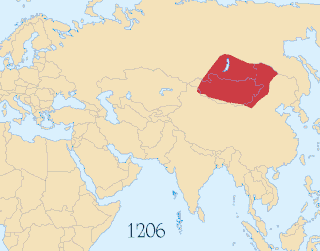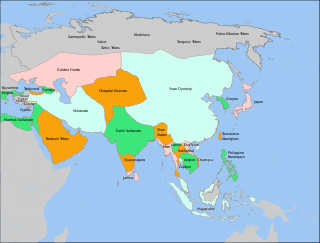Related Research Articles

The Mongol Empire of the 13th and 14th centuries was the largest contiguous empire in history. Originating in present-day Mongolia in East Asia, the Mongol Empire at its height stretched from the Sea of Japan to parts of Eastern Europe, extending northward into parts of the Arctic; eastward and southward into parts of the Indian subcontinent, mounted invasions of Southeast Asia, and conquered the Iranian Plateau; and reached westward as far as the Levant and the Carpathian Mountains.

Giyasuddin Muhammad Uzbek Khan, better known as Özbeg (1282–1341), was the longest-reigning khan of the Golden Horde (1313–1341), under whose rule the state reached its zenith. He was succeeded by his son Tini Beg. He was the son of Toghrilcha and grandson of Mengu-Timur, who had been khan of the Golden Horde from 1266 to 1280.

The Chagatai Khanate, also known as the Chagatai Ulus, was a Mongol and later Turkicized khanate that comprised the lands ruled by Chagatai Khan, second son of Genghis Khan, and his descendants and successors. At its height in the late 13th century the khanate extended from the Amu Darya south of the Aral Sea to the Altai Mountains in the border of modern-day Mongolia and China, roughly corresponding to the area once ruled by the Qara Khitai.
The names of people, battles, and places need to be spelled as they are on other articles title and then wikified.

Berke Khan was a grandson of Genghis Khan from his son Jochi and a Mongol military commander and ruler of the Golden Horde who effectively consolidated the power of the Blue Horde and White Horde from 1257 to 1266. He succeeded his brother Batu Khan of the Blue Horde (West), and was responsible for the first official establishment of Islam in a khanate of the Mongol Empire. Following the Sack of Baghdad by Hulagu Khan, his cousin and head of the Mongol Ilkhanate based in Persia, he allied with the Egyptian Mamluks against Hulagu. Berke also supported Ariq Böke against Kublai in the Toluid Civil War, but did not intervene militarily in the war because he was occupied in his own war against Hulagu and the Ilkhanate.

The Turco-Mongol or Turko-Mongol tradition was an ethnocultural synthesis that arose in Asia during the 14th century among the ruling elites of the Golden Horde and the Chagatai Khanate. The ruling Mongol elites of these khanates eventually assimilated into the Turkic populations that they conquered and ruled over, thus becoming known as Turco-Mongols. These elites gradually adopted Islam, as well as Turkic languages, while retaining Mongol political and legal institutions.
Tughlugh Timur Khan (1312/13–1363) was the Khan of Moghulistan from c. 1347 and Khan of the whole Chagatai Khanate from c. 1360 until his death. Esen Buqa is believed to be his father. His reign is known for his conversion to Islam and his invasions of Transoxiana.
Buzan was khan of the Chagatai Khanate from 1333 to 1334. He was the son of Duwa Temür.
Eljigidey was Khan of the Chagatai Khanate, a division of the Mongol Empire in 1326–1329. He was the son of Duwa. After the death of his brother Kebek, Eljigidey took control of the Chagatai Khanate. He was involved in the succession struggles of the Yuan court from 1327 to 1329. His ally Kusala was enthroned as the Yuan emperor in 1329, but died suspiciously soon after that. The new Yuan emperor, Tugh Temür sent him Naimantai, a descendant of Muqali, in order to mollify his anger with an imperial seal. After only a short period of time, however, Eljigidey was overthrown by another brother, Duwa Temür.
Duwa Temür (Дуватөмөр) or Tore Temur (Төртөмөр) was Khan of the Chagatai Khanate for a period in 1329/1330. He was the son of Duwa.

The Berke–Hulagu war was fought between two Mongol leaders, Berke Khan of the Golden Horde and Hulagu Khan of the Ilkhanate. It was fought mostly in the Caucasus Mountains area in the 1260s after the destruction of Baghdad in 1258. The war overlaps with the Toluid Civil War in the Mongol Empire between two members of the Tolui family line, Kublai Khan and Ariq Böke, who both claimed the title of Great Khan (Khagan). Kublai allied with Hulagu, while Ariq Böke sided with Berke. Hulagu headed to Mongolia for the election of a new Khagan to succeed Möngke Khan, but the loss of the Battle of Ain Jalut to the Mamluks forced him to withdraw back to the Middle East. The Mamluk victory emboldened Berke to invade the Ilkhanate. The Berke–Hulagu war and the Toluid Civil War as well as the subsequent Kaidu–Kublai war marked a key moment in the fragmentation of the Mongol empire after the death of Möngke, the fourth Khan of the Mongol Empire.

Moghulistan, also called the Moghul Khanate or the Eastern Chagatai Khanate, was a Mongol breakaway khanate of the Chagatai Khanate and a historical geographic area north of the Tengri Tagh mountain range, on the border of Central Asia and East Asia. That area today includes parts of Kazakhstan, Kyrgyzstan, and northwest Xinjiang, China. The khanate nominally ruled over the area from the mid-14th century until the late 17th century.

As of 2020, Islam in Mongolia is practiced by approximately 5.4% of the population. It is practised by the ethnic Kazakhs of Bayan-Ölgii Province and Khovd Province aimag in western Mongolia. In addition, a number of small Kazakh communities can be found in various cities and towns spread throughout the country. Islam is also practiced by the smaller communities of Khotons and Uyghurs.
The Mongol Empire launched numerous invasions into the Indian subcontinent from 1221 to 1327, with many of the later raids made by the Qara'unas of Mongol origin. The Mongols occupied parts of the subcontinent for decades. As the Mongols progressed into the Indian hinterland and reached the outskirts of Delhi, the Delhi Sultanate of India led a campaign against them in which the Mongol army suffered serious defeats.
The Qara'unas or Negüderi were the Mongols who settled in Afghanistan after moving from Turkestan and Mongolia.

The Mongols were highly tolerant of most religions during the early Mongol Empire, and typically sponsored several at the same time. At the time of Genghis Khan in the 13th century, virtually every religion had found converts, from Buddhism to Eastern Christianity and Manichaeanism to Islam. To avoid strife, Genghis Khan set up an institution that ensured complete religious freedom, though he himself was a Tengrist. Under his administration, all religious leaders were exempt from taxation, and from public service. Mongol emperors were known for organizing competitions of religious debates among clerics, and these would draw large audiences.

The Yarkent Khanate, also known as the Yarkand Khanate and the Kashghar Khanate, was a Sunni Muslim Turkic state ruled by the Mongol descendants of Chagatai Khan. It was founded by Sultan Said Khan in 1514 as a western offshoot of Moghulistan, itself an eastern offshoot of the Chagatai Khanate. It was eventually conquered by the Dzungar Khanate in 1705.

The siege of Damascus was a major event in 1400–01 during the war between the Timurid Empire and Mamluk Egypt.
References
- ↑ Battutah, Ibn (2002). The Travels of Ibn Battutah. London: Picador. pp. 141–143. ISBN 9780330418799.
- Biran, M. (2002). "The Chaghadaids and Islam: The Conversion of Tarmashirin Khan (1331-34)". Journal of the American Oriental Society. 122 (4): 742. doi:10.2307/3217613. JSTOR 3217613.